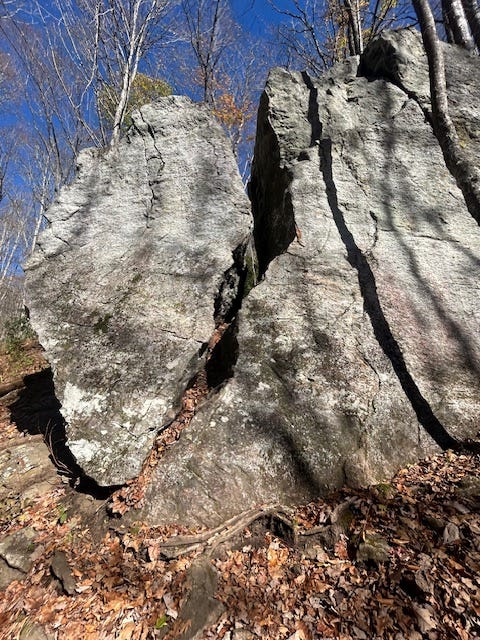Blog #1: Nature Reparenting Wander
A personal example and steps for your own exploration
In the wake of Helene, with my nervous system stuck in overdrive for far too long, I set out on a hike in Sylva with a simple intention: to deeply connect with and support my inner self. As I approached the trail, a familiar resistance arose within me—an urge to distract myself, as if turning inward was unsafe. This inner flailing felt dramatic but humbling—a very human reaction to the vulnerability of self-reflection.
This resistance reminded me of a psychological study where participants were asked to sit alone in a quiet room for 15 minutes. They had the option to give themselves a mild electric shock. Surprisingly, 27% of women and 67% of men chose the shock over the discomfort of sitting with themselves. This highlights how unsettling we can find empty space or quiet introspection.
Determined to move past this resistance, I identified a small wooden bridge along the trail as my threshold. A teacher of mine, Katie Asmus, taught me the power of using thresholds to create a ritual container—a way to mark the transition into sacred, intentional work. As I crossed the bridge, I whispered a request for guidance: “Please help me learn to find peace within.”
From there, I walked with open awareness, letting the steep mountain trail guide me. Soon, I encountered a massive rock shaped like a broken heart. Sitting against it, I felt a wave of emotions: pain, frustration, fear, and shame for not yet finding the inner peace I’ve been seeking. I allowed myself to stay with these feelings, breathing through the discomfort until they began to soften. I thanked the rock for holding that moment with me and continued on my journey.
As I moved forward, I practiced a technique rooted in ecopsychology: inviting nature to reflect back the parts of myself that need care. I let my surroundings guide me, and soon, I found a large, unassuming rock that seemed to call out to me. Placing my hands on its surface, I imagined my younger self—fragile, hurt, and yearning for comfort. Memories and emotions surfaced, and I stood still, offering presence and compassion to the pain I carried.
Nearby, I spotted a tangle of gray beard moss, a natural antibiotic. I picked it up and gently placed it on the rock, offering words of understanding and care. This small gesture symbolized my intention to heal and nurture the parts of myself that feel broken or stuck.
As the trail climbed higher, I found myself on a hill overlooking the vibrant fall landscape. Sitting in a circle of rocks, I imagined myself as my younger self—small, vulnerable, and open to receiving care. I allowed my wiser, present-day self to extend compassion and reassurance, repeating the words of support and love that had flowed through me as I sat with my rock a few minutes prior.
This act of receiving was as vital as the giving. I felt the grounding presence of the earth beneath me, offering a safe space for my inner child to trust and heal.
This walk was the beginning of my nervous system beginning to return back to a state of regulation through the power of connecting with nature and offering attention to the parts of ourselves most in need.
By creating space for vulnerability and self-compassion, we allow our inner wounds to surface and outpouring of empathy and compassion to arise from inside. Our inner wounded selves can receive care, know that they are in good loving hands, and move toward a sense of trust, safety, and wholeness.
Steps to a reparenting wander:
Choose a place outdoors to allow yourself to “wander” in or to explore for a period of time. This could be in your neighborhood, a local park or hiking trail, or potentially even in your own backyard
Identify a young part which is asking for your attention. If you are familiar with Internal Family Systems this could be a exiled part. Remember that our young parts not only can carry wounding, but also contain a lot of hope and magic so for example you could seek an ‘orphaned child,’ or ‘the delighted child.’
Walk through a threshold of your choosing and create an intention for working with this young part.
Allow your self to wander and be drawn to a space/view/natural object that feels right to represent this young part. Once you find this part, spend some time hanging out with it, getting to know it, perhaps dialoging with it. Some questions you might use for this dialogue are: When and how do you show up in my life? How old are you? What messages do you have for me? What can I do to better support you? How can I connect with you? Give any appreciations and name any ways you pledge to be in relationship with this part.
When you feel complete, find a way to end with this natural being. You may offer it gratitude from your heart, a natural gift, or something else. When you are ready to move on, if it feels right, find a space to embody the young part and allow yourself to receive any gestures of care and words of affirmation from your current day self.
Finally, to end this exploration, walk back through the same threshold signifying a return to normal consciousness and routines.


